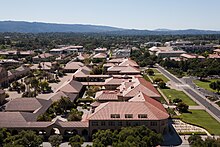

Hoover Tower is a 285-foot (87 m) structure on the campus of Stanford University in Stanford, California, United States. The tower houses the Hoover Institution Library and Archives, an archive collection founded by Herbert Hoover before he became president of the United States. Hoover had amassed a large collection of materials related to early 20th century history; he donated them to Stanford, his alma mater, to found a "library of war, revolution and peace". Hoover Tower also houses the Hoover Institution research center and think tank.
Hoover Tower, inspired by the tower at the New Cathedral of Salamanca,[1] was finished in 1941, the year of Stanford's 50th anniversary. It was designed by architect Arthur Brown Jr.[2]
The first nine floors of the tower are library stacks and the next three floors are used for offices. Exiled Aleksandr Solzhenitsyn lived on the 11th floor for some time upon invitation by Stanford University before he moved in 1976.
Hoover Tower receives approximately 200 visitors per day, and a nominal fee is charged for non-students or non-faculty. The observation deck platform is 250 feet (76 m) above the ground, and provides an expansive view of the Stanford University campus and surrounding area. On clear days it is possible to see all the way to the distant skyline of San Francisco. The tower's observation deck is open daily from 10:00 a.m. to 4:00 p.m., but closed during academic breaks and finals.
In December 1970, Hoover Tower was struck by lightning, causing a 300-pound (140 kg) ornamental concrete ball to fall from the top of the tower onto a parking lot.[3] In August 2020 the concrete ball at the tower's tip was struck down by an electric storm again, shattering into multiple pieces.[4]
- ^ "The Hoover Library". Time. June 30, 1941. Archived from the original on April 12, 2011. Retrieved March 25, 2008.
- ^ "Hoover Institution: About HILA". Archived from the original on March 16, 2008. Retrieved March 25, 2008.
- ^ Kneeland, Douglas E. (December 20, 1970). "Campuses Quiet but Not Content". The New York Times.
- ^ Streiff, Lara (August 17, 2020). "Lightning strikes Stanford's Hoover Tower – again". Stanford University. Retrieved November 28, 2020.